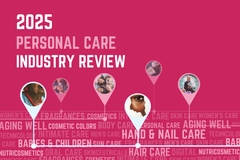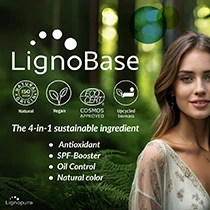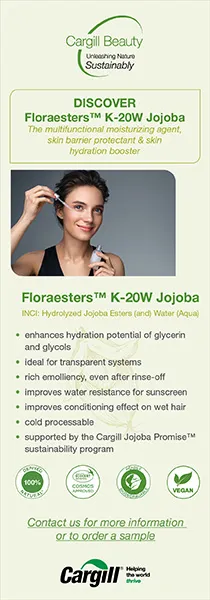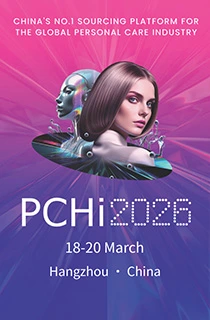Givaudan unveils circular beauty innovations, and researchers upcycle prickly pear into sun-protecting body lotion

12 Mar 2024 --- Circular economy principles are emerging as pathways to sustainable innovation and manufacturing. Personal Care Insights explores the impact on the cosmetics industry with Givaudan and looks into recent research plus a case study on upcycling prickly pear pomace.
A recent ScienceDirect literature review uncovered strides made by the cosmetics industry in integrating circular economy principles, emphasizing the four R’s — reduce, reuse, recycle and recover. With rising environmental, economic and societal concerns, cosmetic companies are driven to find enduring solutions for sustainable development.
Meanwhile, Givaudan Active Beauty’s Alexis Rannou, head of operations strategy and Mathias Fleury, head of category Actives, reveal circular approaches the manufacturer is exploring and using, such as:
- Upcycling raw materials when possible and upcycling raw materials from qualified sourcing to valorize the existing flow.
- Water recycling with reverse osmosis.
- Saving energy with heat insulation.
- Retrocontrol on aeration during fermentation to feed it only when needed. Track of the air leak.
- Sterilization by filtration instead of by heat to limit the usage of gas and waste vegetable residues reused in methanization to produce biogas.
“We keep investing in the framework of this biorefinery around our site, with new investments coming, and the synergy between all the local actors still at the heart of our developments. We’ll keep on using local resources (biomass or products derived from this biomass) produced by local actors (farmers and industrials) to produce our high-value cosmetic ingredients, valorizing the work of a whole local area,” Rannou tells us. Interconnection between circular economy concepts and cosmetics (Image credit: University of Messina).
Interconnection between circular economy concepts and cosmetics (Image credit: University of Messina).
Givaudan’s sourcing and LCA tools
Fleury discusses the Givaudan production facility, located in the center of a biorefinery in Pomacle, France.
“There, we can work in collaboration and synergy with local actors to source local biomass (wheat, rapeseed, sugarbeet) or raw materials derived from it (bio-ethanol, wheat peptide) and recycle our by-products (the water used in our process is then used by the farmers to ferti-irrigate their fields and the gas we produce is used by a world leader in industrial gas production).”
“This has a huge impact on circularity, local economy and ethical considerations. The biorefinery is responsible for more than 1,200 direct jobs, encourages local production and agriculture and positively impacts the whole local area.”
Rannou describes specific initiatives to minimize waste generation throughout the supply chain “using precision fermentation and biofoundry to produce more with less.”
He highlights PrimaHyal 50 Life, a low molecular weight HA (LMW HA), which has emissions at five and RM usage at four. “Or using actives such as DHA (self-tanning agent) in liquid form versus powder form to keep the same usage for consumers but to prevent over processes such as drying when it is not mandatory.”
Fleury adds: “More and more, we use a life cycle approach to estimate the impact of our processes on the environment, biodiversity, human health or resources. The life cycle assessment (LCA) is a wonderful tool to demonstrate the power of innovation regarding the impact we can make on our planet.”
PrimalHyal 50 Life leverages a new way to produce LMW HA thanks to an LCA, with a 91% lower impact than the conventional process for LMW HA production, he says. Identified circular economy practices in the cosmetic industry (Image credit: University of Messina).
Identified circular economy practices in the cosmetic industry (Image credit: University of Messina).
“We are also working with a specialist (EVEA) and our key suppliers to obtain LCA on key and strategic products. The group is putting in place the carbon footprint of our hero molecules for the end of the year by using Simapro software,” continues Fleury.
Input valorization
The ScienceDirect review categorizes circular practices into four pillars: Governance and management, output valorization, packaging solutions and input valorization. Even though each pillar is essential, input valorization stands out because it changes how cosmetic products are formulated, according to the authors.
It finds that used materials in cosmetics mainly derive from agri-food waste and by-products — transforming industrial waste and by-products into valuable ingredients. Bioactive compounds from agri-food waste emerge as sustainable alternatives, boasting anti-aging, antioxidant, antimicrobial and anti-inflammatory properties.
Cosmetic companies are reevaluating where they source their raw materials in response to environmental pressures. According to the review, there is a shift toward more environmentally friendly options that comply with REACH (registration, evaluation, authorization and restriction of chemicals) and other regulations. Organic and natural products are becoming more popular, but ensuring they perform as well as their conventional counterparts is still challenging. Turning prickly pear pomace into body lotion (Image credit: Campus Universitário Santiago, et al.)
Turning prickly pear pomace into body lotion (Image credit: Campus Universitário Santiago, et al.)
Prickly pear waste upcycling
Another study targets the circular economy approach for body lotions with solar protection using Opuntia ficus-indica seed pomace (or prickly pear), a by-product of seed oil extraction. This offers a sustainable solution by transforming waste into a valuable beauty resource.
Opuntia ficus-indica L. is a resilient cactus species that has long been an agricultural asset in regions like Mexico, Africa, Australia and the Mediterranean. This cactus yields fruits and seeds with high oil content. However, the increased cultivation of prickly pear has led to a surge in food waste, prompting exploration into its applications beyond traditional uses.
A circular approach
The study focuses on Opuntia ficus-indica seed pomace, rich in phytochemical compounds and antioxidants. The pomace undergoes hydrothermal extraction at temperatures ranging from 120 to 220°C as the demand for cleaner extraction techniques has increased.
The method, known as autohydrolysis, only uses water as a solvent and reagent, aligning with the green principles sought in modern cosmetic practices, note the authors. The goal is to extract bioactive compounds while efficiently reducing environmental impact.
Increasing extraction temperatures correlate with higher phenolic compounds and antioxidant activity, peaking at 200°C. The findings show potential for developing sustainable cosmetic ingredients with natural benefits.
Notably, the researchers used the phenolic compounds in the extracts to formulate a body lotion with a SPF of eight. They found the lotion showed similar rheological behavior to commercially available products.
Moreover, the sun-protective lotion does not rely on additional UV filters and antioxidants, offering a greener alternative for skin protection.Simapro software (Image credit: Givaudan).
Sustainability gap
The ScienceDirect review notes that businesses are emphasizing the entire supply chain in addition to product formulation to meet customers’ expectations for sustainability. However, as the circular economy gains traction in the cosmetic sector, challenges persist.
There is room for investigation into how businesses can shift to a circular economy paradigm, as the literature review indicates a gap in entrepreneurial perspectives. Additionally, even though the connection between circular economy and sustainability is clear, there is still room for exploration, say the authors.
Meanwhile, Innova Market Insights data indicates that the prevalence of sustainability claims in cosmetic releases is rising worldwide, showing year-over-year growth of +3% from October 2020 to September 2023. Face/Body Cosmetics were the leading category for these sustainable launches. The top claims were Ethical – Animal/Fish & Bird, Packaging and Human.
According to the study, the cosmetics industry faces environmental problems related to packaging materials. Programs such as the Sustainable Packaging Initiative for Cosmetics address the issues of plastic waste and product preservation by focusing on using bio-based and renewable materials.
Meanwhile, Givaudan emphasizes selective sorting of waste, recycling efforts and wastewater reuse for crop irrigation to reduce emissions.
By Venya Patel












